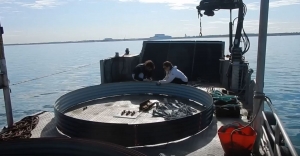How Ningaloo whale shark snaps help international research
Commercial tour boat photographers take tens of thousands of photos every year of excited snorkellers enjoying close encounters with Ningaloo Reef’s magnificent whale sharks. But their photos, showing the distinctive spots and markings on the big fish, are also being shared in scientific catalogues to be used by researchers around the world.
It’s a scientific spin-off to a tourism industry that has taken off in Exmouth since swimming with whale sharks was allowed under regulated conditions.
Dr Kelly Waples, from the Department of Biodiversity, Conservation and Attractions, spoke to year 12 marine science students this year, as part of WAMSI’s Thinking Blue lecture series, about whale shark tours and other ecotourism ventures.
“We know humpback whales and whale sharks have long range migratory movement so this area around Ningaloo Reef near Exmouth is only a small part of where they spend their time,” Dr Waples said.
“Photographs of the whale sharks can be used in an international scientific catalogue.”
“We can identify individuals and get a better understanding of their movements including how often they might return to the marine park as well as some of the other places they might visit, how many times they are interacted with by tourists and how these interactions fit into the lifespan of the animals.”
“We use a range of other information that the tour operators provide through an electronic management system to help us evaluate the industry,” she said.
Other ecotourism operations that are allowed under regulation in Western Australia include swimming with humpback whales in Ningaloo and snorkelling interactions with Australian sea lions.
Dr Waples said ‘in-water’ encounters with humpback whales were first trialled in 2016. A humpback whale interaction program has since been developed with management strategies including a permanent licenced industry for up to 15 licensed operators in Exmouth and Coral Bay. Exmouth and Coral Bay are the only locations in the state that provide in-water interactions with humpback whale tours.
“Managing ecotourism activities in WA is an ongoing process and we assess and evaluate the businesses regularly.
“One of the key principles of ecotourism is to promote conservation, so we need to make sure messages about the environment are getting out there,” she said.
“Licensing is often used as a way of managing ecotourism and this can include creating time and zone restrictions, so the animals can have a break from interactions and not be disturbed during critical activities.”
Dr Waples said the licensed operators must adhere to numerous conditions around attempted in-water interactions with humpback whales. They are not allowed closer than 75 metres to the side of a humpback whale and swimmers must not approach the humpback whale closer than 30 metres.
There are also interaction limits to minimise potential disturbance to humpback whales and requirements for operators intending to interact with mothers and calves. This included aerial support to determine the presence and size of the accompanying calf. Licence conditions are administered to minimise risk to animal welfare and swimmers.
You can see Dr Waples’ lecture here.

